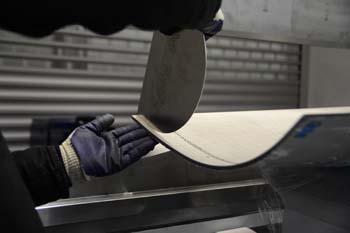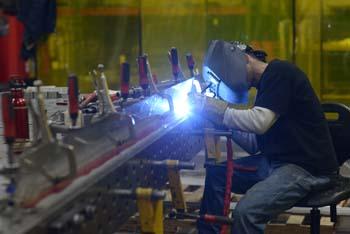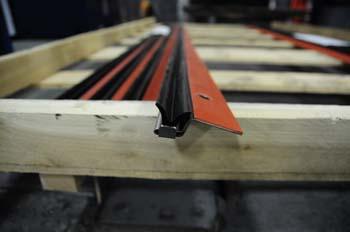Senior Editor
- FMA
- The Fabricator
- FABTECH
- Canadian Metalworking
Categories
- Additive Manufacturing
- Aluminum Welding
- Arc Welding
- Assembly and Joining
- Automation and Robotics
- Bending and Forming
- Consumables
- Cutting and Weld Prep
- Electric Vehicles
- En Español
- Finishing
- Hydroforming
- Laser Cutting
- Laser Welding
- Machining
- Manufacturing Software
- Materials Handling
- Metals/Materials
- Oxyfuel Cutting
- Plasma Cutting
- Power Tools
- Punching and Other Holemaking
- Roll Forming
- Safety
- Sawing
- Shearing
- Shop Management
- Testing and Measuring
- Tube and Pipe Fabrication
- Tube and Pipe Production
- Waterjet Cutting
Industry Directory
Webcasts
Podcasts
FAB 40
Advertise
Subscribe
Account Login
Search
Inspired fabrication atop One World Trade Center
Brooklyn job shop fabricates a bit of history
- By Tim Heston
- July 2, 2013
- Article
- Shop Management
Sam Kusack remembers the sunshine and the clear, pollution-free air of a seemingly perfect day. He remembers leaving his industrial loft, a humble Brooklyn workspace where he had recently launched Kusack Architectural Metals, or Kammetal Inc., to pick up some supplies at the local hardware store.
Browsing for tools, he glanced up and looked through the pane glass storefront, and there it was: a monstrous plume emerging from one of the towers in lower Manhattan. He recalled how eerie it felt. The store clerk, his friends, no one really knew the details yet. He remembered returning to his loft workshop and climbing up to the roof for a better view, where he witnessed the horror.
In May of this year, Kusack and his employees stood outside the company’s current facility in Brooklyn’s Red Hook neighborhood, near the Battery Tunnel, also with a clear view of lower Manhattan. This time they witnessed the American flag-draped spire—with the stainless steel skin they engineered and fabricated—being hoisted atop One World Trade Center.
The media circus covering the event didn’t visit the shop, and it was just as well. Employees weren’t looking for attention. They instead looked on, smiled, and enjoyed a quiet sense of accomplishment. Then they turned around, went back inside, and got back to work.
Backyard Steel
Kusack got into fabrication despite his lack of exposure. His high school didn’t have much of a shop program, and his parents didn’t work in manufacturing. His mother is a photo editor; his father works in real estate. But their son always seemed to have a drive for artistic creation; his medium just happened to be metal.
Kusack went on to The Cooper Union in the East Village, graduating in 2001 with a bachelor’s degree in fine arts. There he received formal training on some fabrication basics and did a lot of research on his own, poring over welding and fabrication texts. By his first summer break, he had purchased an arc welding power source and an oxyacetylene tank, and practiced his technique in oxyfuel, shielded metal arc, gas metal arc, and finally gas tungsten arc welding.
“I just went to town in my parent’s backyard,” he said.
Neighbors knew when the Kusack boy was busy: A truck dropping off 1,500 pounds of steel in the front yard was hard to miss. “Back then I really became interested in metal from a structural and sculptural standpoint,” he said. “It became my passion, and it eventually became my trade.”
He had welding talent, and the teachers at Cooper Union recognized that. So when people called the school asking for help welding, say, a display cabinet or sculptural component, the teachers often recommended Kusack first. People in the community began to notice, too, so after graduation it seemed natural for the young welder to rent an industrial loft space in Brooklyn and start his own shop—just him, some welding equipment, and a chop saw.
He also had a knack for 3-D CAD. He had worked with SolidWorks® since acquiring a copy during his school days, and from the start he employed solid modeling in his work.
Four years ago the business employed about seven people, including two project managers, which wasn’t enough to handle the workload.
“My brother Alastair wasn’t working at the time, and I needed a project manager, so I asked if he wanted to help me out,” Kusack said. A Caltech engineering graduate, Alastair started part-time but eventually got more involved, becoming vice president and eventually Sam’s business partner.
“We now do a lot of engineering and product prototyping, design development, and project management,” Sam said, adding that the company evaluates drawings to ensure components can be fabricated and installed reliably and cost-effectively, while maintaining the designer or architect’s original vision.
In 2007 Kusack moved the business into its current space in Red Hook, not far from the water. Soon the shop began to land bigger jobs, including one large contract for furniture, lighting, and miscellaneous fabrication for a national restaurant chain. To meet demand, the company purchased a Flow waterjet with a 60,000-PSI intensifier pump, a TRUMPF 1030 CO2 laser cutting system with a shuttle pallet changer, along with a new press brake. Today the shop employs about 25, including six welders.
Inspiring Work
In 2012 the call came. A project manager from DCM Erectors, the company responsible for building the new World Trade Center, wanted to talk to the Kusacks about fabricating the architectural encasement surrounding the top 50 feet of the building’s spire. They bid on the job along with about 15 other companies, and the Kusacks ultimately won the contract.
“It was a long process of delving into the details,” Sam recalled.
The design called for 0.25-in.-thick stainless steel panels of abutting triangles as well as several glass panels encasing a rotating beacon to light the New York skyline. The cladding enclosed the spire’s core, which DCM fabricated from structural tubes. The initial plan was to fully weld these laser-cut triangular sections, but that didn’t allow for thermal expansion or other environmental effects; it gets windy 1,776 feet in the air. This would have made any such fully welded structure susceptible to cracks.
So the Kusacks met with a consulting engineer to develop another approach. They ultimately designed a system of stainless steel clips to hold custom silicon gaskets in between each panel, allowing each panel to move independently. Various brackets inside, connecting the panel assembly to the substructure, were joined to the frame using arc and capacitive discharge stud welding.
Most clips were cut on the laser and bent on the brake. But a few were unbendable because of minimum flange conditions and specific geometries like cutouts and contours. This is where GTAW came into play.
“We had tight constraints in terms of how much space we had to work with designing the connections [between the panels and interior structure]," Sam said. That space had to be tight to meet design requirements and the designer’s artistic intent.

The press brake operator checks the bend, comparing the start of the bend to the laser-cut radius template.
“From the outside, it looks simple, but the devil’s in the details,” Sam said. “The assembly had thousands of parts.”
Before they began fabrication, the Kusacks had the structural frame 3-D laser-scanned to capture an exact digital image of the spire’s existing tubular core. “We took every detail into account, considering the [core] structural frame had full-penetration welds,” Sam said. “We had it scanned so we could account for any kind of fabrication warpage.” That scanned model then was imported into 3-D CAD, where the company designed the clips, silicon gaskets, and panels on top.
“Because we had [the substructure] scanned, we could go into the detail and use 3-D CAD on the front end to work around our constraints,” Sam said. “We spent a lot of time engineering the connection system.”
Unfortunately, during the middle of all this, Sandy blew in. The facility, just a few yards away from the water, flooded significantly and put equipment out of commission in short order. The company worked with its vendors to repair and replace equipment, and within a month the project marched onward. Earlier this year workers stood on a street—previously flooded and awash with debris after the superstorm—now dry, clean, and with a clear view of the rising spire atop One World Trade Center.
Rewarding Innovation
Today Kammetal still produces gallery and museum displays as well as outdoor sculptures, but most revenue comes from low-volume production work involving lighting, furniture, and other architectural components. The shop also fabricates a fair amount of miscellaneous items like store displays and fixtures.
Like many entrepreneurs in this business, Sam has a sense of humility. “We’re really just a job shop, like everyone else,” he said. Like many shops, the company employs a band of highly talented people. “We’ve been pretty lucky, really,” he said. Most went to trade schools or have worked in metal fabrication for years.
Yet the fabricator continues to have trouble finding more help. The city schools (similar to others across the country) aren’t helping, with manufacturing education programs being cut. As Sam explained, most kids graduating today have never attended a shop class.
As Sam put it: “We’re not day-trading. We’re not bouncing numbers around. We’re making money with a lot of hard work, sweat, and tears, and the margins aren’t high. But the rewards are greater than that. It’s not about the money. We really want to foster more pride and passion out there, so people feel happy to be learning a trade and continually improve what they do. We work hand in hand with architects and designers to make their design a reality. We’re really an extension of what they want to create, and there’s a lot of innovation in that.”
The Kusacks look a bit like they could have stepped off the set of “Dead Poets Society” or from any number of real-life New England prep schools. But their pursuit isn’t any less intellectual. That’s because it’s not just about hands-on skill. It’s about paying attention to detail, communicating, shepherding a project to its fruition, and relating to people’s sense of style and creativity.
It’s a tough combination to find for Kammetal and most job shops like it. But the people who do develop and nurture the talent reap the rewards. The people at Kammetal have it. If they didn’t, they probably wouldn’t have fabricated a piece of history.
Flow International Corp., 23500 64th Ave. S., Kent, WA 98032, 253-850-3500
About the Author

Tim Heston
2135 Point Blvd
Elgin, IL 60123
815-381-1314
Tim Heston, The Fabricator's senior editor, has covered the metal fabrication industry since 1998, starting his career at the American Welding Society's Welding Journal. Since then he has covered the full range of metal fabrication processes, from stamping, bending, and cutting to grinding and polishing. He joined The Fabricator's staff in October 2007.
Related Companies
subscribe now

The Fabricator is North America's leading magazine for the metal forming and fabricating industry. The magazine delivers the news, technical articles, and case histories that enable fabricators to do their jobs more efficiently. The Fabricator has served the industry since 1970.
start your free subscription- Stay connected from anywhere

Easily access valuable industry resources now with full access to the digital edition of The Fabricator.

Easily access valuable industry resources now with full access to the digital edition of The Welder.

Easily access valuable industry resources now with full access to the digital edition of The Tube and Pipe Journal.
- Podcasting
- Podcast:
- The Fabricator Podcast
- Published:
- 04/16/2024
- Running Time:
- 63:29
In this episode of The Fabricator Podcast, Caleb Chamberlain, co-founder and CEO of OSH Cut, discusses his company’s...
- Trending Articles
AI, machine learning, and the future of metal fabrication

Employee ownership: The best way to ensure engagement

Steel industry reacts to Nucor’s new weekly published HRC price

Dynamic Metal blossoms with each passing year

Metal fabrication management: A guide for new supervisors

- Industry Events
16th Annual Safety Conference
- April 30 - May 1, 2024
- Elgin,
Pipe and Tube Conference
- May 21 - 22, 2024
- Omaha, NE
World-Class Roll Forming Workshop
- June 5 - 6, 2024
- Louisville, KY
Advanced Laser Application Workshop
- June 25 - 27, 2024
- Novi, MI





























